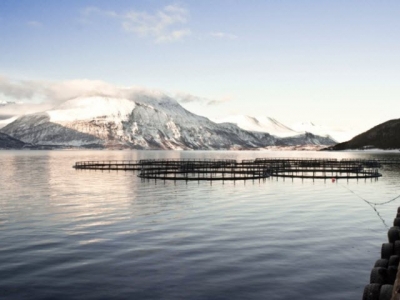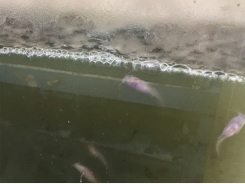Does a spoonful of fish feed help the medicine go down?

DNA-supplemented feed may offer an efficient method of mass vaccination for farmed Atlantic salmon facing disease challenges, say researchers.
A team of researchers in Chile examined the use of a novel formation process for a DNA-based vaccine that coded for a specific immunogenic region of the VP2 protein to support a health response in Atlantic salmon against infectious pancreatic necrosis (IPN). “We further investigated the safety of the vaccine in terms of the fish growth and histologically, as well as from an environmental point of view, by determining its presence in the tank water, feces and unconsumed feed sediments,” they added.
The research team found that the use of an oral DNA vaccination in the salmon feed was able to protect the fish from the disease challenge by increasing the production of specific antibodies and boosting survival.
“We demonstrated that oral delivery via feed of a liposomal (DOTAP-based) formulation of a DNA vaccine coding for a central region of the VP2 protein can successfully stimulate a strong protective response against IPNV in Atlantic salmon,” they said. “These results support the use of the ‘in-feed’ technology for oral DNA vaccination, showing it is a promising strategy for effective and massive fish immunization in the aquaculture industry.”
1/ Why a novel in-feed vaccination?
Aquaculture is a growing industry and offers a major contribution to human nutrition, said the researchers. And, in recent years the use of DNA or genetic vaccination has been found successful against different fish pathogens.
“Infectious pancreatic necrosis (IPN) is an economically important fish disease caused by a virus (IPNV) belonging to the Birnaviridae family, which produces severe acute infections and high mortality in young salmonids and post-smolts,” they said. “IPNV has a bisegmented genome of double-stranded RNA, with segment A encoding the two major structural proteins of the virus (VP2 and VP3). VP2 (54 kDa) is a protective antigen that induces virus neutralizing antibodies.”
DNA vaccines use a plasmid construct to code for an immunogenic or pathogen protein and can be used to provoke a protective immune response in a fish, they said. However, the preferred method for administering them is through injection.
But finding a successful oral practice would be preferred because it is less stressful for the fish, said the researchers. Several strategies have been described to use an oral delivery while protecting the pDNA from the trip through gastrointestinal tract.
“For IPNV, challenge studies have confirmed strong protections against this virus in rainbow trout orally vaccinated with alginate-based microencapsulated plasmids coding for the VP2 gene,” they said. “However, further research is needed to improve pDNA formulations and to address safety concerns, especially considering the potential ecological effects caused by environmental distribution of pDNA.”
The process tested used a novel technology to add the liposomal DNA to feed pellets before feeding them to the fish, they said. “To the best of our knowledge this is the first study in aquaculture addressing the use of liposomes for oral delivery of DNA vaccines via feed,” they added.
2/ Study details
In the initial feeding trial, 1,350 young Atlantic salmon were given the DNA supplemented feed at one of three different levels for a period of seven days, said the researchers. The tested diets included 0.2, 0.6 and 1mg per kg of the pDNA and a negative control.
Fish were collected on days 0, 15 and 45 after vaccination to run analyses, they said. In the sampled fish, the liver and pancreas were collected for histological examination of vaccine effect and blood samples were taken to check for antibody response.
In a second feeding trial, 2,000 young Atlantic salmon were given diets that included vaccine doses at 1 or 2 mg pDNA per kg or injected with the vaccine, said the researchers. Again a negative control was used.
Blood samples were collected at 0, 100, 200, 300, 400, 600 and 800 accumulated thermal units (68 days), they said. Blood was checked for cell count and leukocytes.
On day 68 post supplemented feed the fish were challenged with a virulent strain of IPNV, said the researchers. Mortality was tracked for 30 days and the relative percent survival (RPS) was calculated.
3/ Results
In the initial feed trial, no differences in weight or length were found from any of the diets or the control, said the researchers. “The administration of the oral vaccine didn’t affect the normal fish growth, suggesting no detrimental effect over nutrient assimilation,” they added.
There also were no histopathological alterations in the pancreas or the liver, they said. But, a difference in antibodies was seen at day 45 between the control and the group getting the largest amount of DNA supplement.
In the second test, the fish getting the double dose of the supplemented feed had the best survival rate, said the researchers. Those getting one dose had an RPS rate of 58.2% and those that received an additional round of the test feed had an RPS of 66%, while the group given injections had a 47.8% RPS and the control group was at 30% RPS, they said.
“The delivery platform for liposomal DNA vaccination via feed was successfully proved against IPNV in Atlantic salmon, showing the oral vaccine to be immunogenic and safe for fish, and providing significant protection after oral administration,” they said. “The ‘in-feed’ technology for oral DNA vaccination holds potential to be applied against IPNV and other pathogens that currently threaten the aquaculture worldwide.”
However, they added, that solid wastes should be treated to avoid transferring vaccine residue.
Source: Vaccine
Authors: M Reyes, C Ramírez, I Ñancucheo, R Villegas, G Schaffeld, L Kriman, J Gonzalez, P Oyarzun
Có thể bạn quan tâm
Phần mềm

Phối trộn thức ăn chăn nuôi

Pha dung dịch thủy canh

Định mức cho tôm ăn

Phối trộn phân bón NPK

Xác định tỷ lệ tôm sống

Chuyển đổi đơn vị phân bón

Xác định công suất sục khí

Chuyển đổi đơn vị tôm

Tính diện tích nhà kính

Tính thể tích ao hồ




 Yeast, plant extracts may support farmed salmon in…
Yeast, plant extracts may support farmed salmon in…  Biofloc technology holds potential for carnivorous fish species
Biofloc technology holds potential for carnivorous fish species